MORE ON COOLING YOUR MORGAN
GENERALLY
Heat is normally a symptom of some engine or combustion
malaise. Any discussion on cooling must start with the premise that the
reader has ruled out poor timing, too lean an air/fuel mixture, bad coolant,
a radiator or cooling system blockage, a faulty water pump, bad combustion,
poor lubrication, a lousy rad fan, a malfunctioning sensor, a bad thermostat,
an imprudent camshaft selection or "badge" blockage.
Cooling a car generally concentrates on coolant temperatures
and secondarily oil temperatures.
The coolant heat is dissipated by its passage through
the radiator which is turn cooled by the flow of air that runs through
it. As this flow of air greatly increases with speed and idling engine
gets hotter than a cruising engine. Systems to deal with a stationary or
slowly moving car must compliment the systems used to cool a cruising car.
WHEN CRUISING
Morgan cowls restrict the possibility of large radiators.
The louvres do not improve the airflow much and must be considered decorative.
The flow of air is funneled through the grill or from under the car. This
being the case, the following aids may help when moving.
1. Especially for 4/4s and Plus 4s the areas between the
radiator and the cowl sides should be closed off to close the escape route
of the needed airflow and force it through the radiator.
2. Install an air "dam" or rubber mat deflector underneath
the car to force the cool low air (the lower the air from the ground the
cooler it will be) up into and around the radiator.
3. 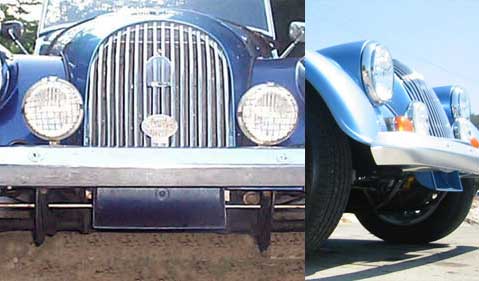 Even
better than 2. install an air scoop that will
funnel large amounts of cool low air into the front of the radiator. A
scoop can double the air flow into the rad. There is a Morganesque version
designed by Maurice Owen and Bill Fink that replaces the original scuttle
(the piece at the bottom of the grill cowl attached to the wings) with
a new scuttle shaped "S" funnel that forces the air up from under the car
and into the rad. It is remarkable how well these scoops can work. They
are available from Isis Imports in San francisco or from the Morgan Factory.
Even
better than 2. install an air scoop that will
funnel large amounts of cool low air into the front of the radiator. A
scoop can double the air flow into the rad. There is a Morganesque version
designed by Maurice Owen and Bill Fink that replaces the original scuttle
(the piece at the bottom of the grill cowl attached to the wings) with
a new scuttle shaped "S" funnel that forces the air up from under the car
and into the rad. It is remarkable how well these scoops can work. They
are available from Isis Imports in San francisco or from the Morgan Factory.
4. Avoid "badge blockage" which occurs when our affection
for badges on a badge bar and badges on the grill create a significant
blockage of the free flow of air through the grill to the rad.
5. Be careful of your placement of your license plate...if
you are unfortunate enough to live in a jurisdiction where front
license plates are required try to place it to the side rather than the
center of the car if possible. A central placement of the license plate
blocks the flow of air under the radiator and makes an air scoop impossible
and prejudices even a simple air deflector.
WHEN MOVING SLOWLY OR STATIONARY
When moving slowly or when stationary the radiator does
not have enough speed induced air flow to cool well. If these conditions
continue, the car will overheat. The solution is to artificially create
an airflow when needed with a fan. Obviously, the higher the power of the
fan the more the airflow and the greater the cooling ability you will have
when needed. Morgan fans are not famous for power but many good replacements
are available. (see SPAL)
1. Do not install a fan mounted in front of the radiator.
They are an easy install and inexpensive but they create the problem they
are supposed to resolve. They block the airflow to the rad which contributes
to the overheating and then they come on in effort to cool the rad to the
point where they can stop and block the airflow again.
2. Install the fan to operate on a radiator thermoswitch
(if you don't already have one installed). This item switches the fan on
at a certain temperature and off at a lower one. You can also install an
manual switch override that forces the fan on regardless of coolant temperature
to deal with a heating situation before it develops fully. Check with your
supplier if you require a larger relay switch for the fan you purchase.
3. Remember that all rear mounted rad fans PULL air through
the radiator. If you see your fan pushing the air back towards the radiator
then simply reverse the wire leads to the fan and recheck the rotation.
IN ALL CONDITIONS
A BETTER RADIATOR.
Morgans are sporting old radiators, some as old as forty
years. Their engines do not function as they once did, greater friction
than originally is the rule and their radiators are no longer up to the
original state of the engine let alone today's state. A better radiator
improves cooling whether stationary or moving, but what is a better radiator?
Here are some answers;
1. You have had your original radiator re-cored or you
have had the coolant flow system of the radiator and the cooling facade
and fins renewed. The rad returns (hopefully) to its original cooling abilities.
The drawback here is whether the original cooling capacity of the radiator
is sufficient for the present state of the engine. You have ignored the
benefits of technological progress in the last forty years and you have
used the old rad as a base which may be less than a solid foundation.
2. You have purchased a radiator larger capacity than
the original though it is conventionally designed. The only drawback here
is the technological one noted above and any loss of space considerations.
3. You have had an technologically advanced core installed
to replace the original. A good option..but at this point why not go all
the way?
4. The ultimate...a high tech aluminum radiator.
See An Aluminum Radiator
for Your Morgan.
COATING YOUR MANIFOLDS
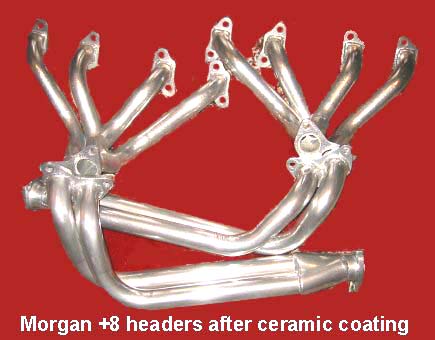 For
some time, there has been an option increasingly offered of coating your
manifolds or heddars with a ceramic based compound that very much lowers
the heat of this part of your exhaust system..a prime radiator of heat.
Essentially the compound..in a choice of colors or effects, is sprayed
on your clean sandblasted manifolds and then baked. It is inexpensive and
aethetically very good looking, replacing the rust that all Morgan manifolds
arrive with even when new. It does not discolor as does stainless steel
(which doesn't lower heat).
For
some time, there has been an option increasingly offered of coating your
manifolds or heddars with a ceramic based compound that very much lowers
the heat of this part of your exhaust system..a prime radiator of heat.
Essentially the compound..in a choice of colors or effects, is sprayed
on your clean sandblasted manifolds and then baked. It is inexpensive and
aethetically very good looking, replacing the rust that all Morgan manifolds
arrive with even when new. It does not discolor as does stainless steel
(which doesn't lower heat).
Make sure that the INSIDE of the manifold is coated..this
is more important than the aesthetics of the outside. There are a number
of companies in the field and some can be found in the GoMoG General
Parts Directory . Be careful of some of the better known firms which
coat their products in bulk lots of many customers at a time, leaving a
orange-peel effect to the finish.
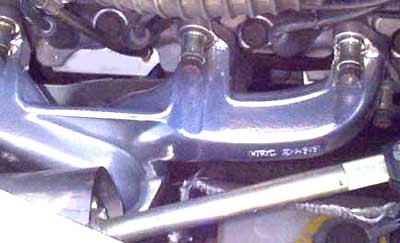 Curiously,
I have only found one coating service in the UK or Europe..though they
are common now in North America, New Zealand, Australia, and Japan.
Curiously,
I have only found one coating service in the UK or Europe..though they
are common now in North America, New Zealand, Australia, and Japan.
N.B. Please ignore the claims of massive horsepower
increases. These are largely pipe-dreaming fancies...though a cooler engine
can produce more power and leaves more room for "tweaking" than one
which is already running hot.
Wrapping your Headers
Many people still use heat wraps to lower their engine
bay temperatures. Essentially, these are a wrap insulation which must be
tediously wrapped around each exhaust branch. It is considered by many
to be unsightly and will very much accelerate the rusting of the manifolds.
They also, of course, do not improve the inner surface of the manifolds
and thusly do not speed the flow of gases. They can, however, block the
heat from the wrapped section.
Coating vs Wrapping
I get asked this question quite often, and there’s really
no easy answer since each application is different, and everyone has a
different budget. But in a nutshell, ceramic coating is the better option.
There are two issues when using a wrap that do not come
into play when using a ceramic coating. These issues are thermal fatigue
and moisture corrosion.
THERMAL FATIGUE
Wraps decrease under hood and under wing temperatures
and because of that save other components. But they also shorten the life
of your exhaust. Wrapping promotes thermal fatigue of the component you
wrapped. It is a type of metal fatigue caused by repeated heating and cooling,
also called creep damage which leads to premature component failure. Some
owners believe that wraps help prevent thermal fatigue, but in fact, it
is the opposite.
Wrap your headers and a few years later, there are holes
in the piping. This can happen quicker than you might think.
MOISTURE
Moisture is the second issue with exhaust wrapping. The
wrap will actually pull moisture in and keep it there, holding it against
the component, which speeds up the corrosion process. Ceramic coatings
are self-sacrificial in design, meaning that they will corrode/rust/oxidize
before the substrate underneath will. It’s a good idea to go with a coating
company that offers a warranty, be careful of companies that only cover
'rust-through', meaning that there has to be a hole in your exhaust before
it will get covered!
Coating the Exhaust
The best option to manage heat is to have your exhaust
ceramic coated. The coating actually bonds to the substrate (at about 10,000
psi) and prevents the heat from soaking into the substrate. If you get
it done right, the rate of expansion of the coating will match that of
the substrate, or the metal your manifold is made of. Your exhaust component
can usually be coated on the inside as well, giving it thermal and corrosion
protection inside and outside.
It’s also a good idea to go with a company that creates/manufactures
their own coatings, not one that just buys it from an online coatings store
and slaps it on. There's a lot more to the application/preparation than
you would think, and if a company has the resources to manufacture their
own coatings, odds are they’ve been in the game a long time and have the
processes to near perfection. The downside to ceramic coatings is of course
the cost. You can get enough wrap to do most of your exhaust for around
$50-$100, compared to a full system getting coated for around $500. You
get what you pay for.
Top quality ceramic coatings can reduce engine bay temps
by over 50%, and the more common cer-met or ceramic-metallic coatings can
reduce temperatures from 30%-40%. Another added benefit is that you will
see power gains anywhere from 3-5% by keeping the exhaust gas velocity
up. Increase spool-time in a turbo system, and increased scavenging is
another benefit of the increased exhaust gas velocity.
So, when the time comes to do some heat management, do
some research for yourself, look at your budget, and determine which direction
is best for you. If you can only afford the wrap at that point in time,
get it so you don’t cook the rest of your components in your engine bay,
just keep in mind that it’s a “quick fix” and get your components coated
when you come into a bit of cash.
The Thermostat
The
thermostat is widely misunderstood by owners and some in the trade
alike..(most often the race crowd). Beware. They believe it has
something to do with controlling temperature 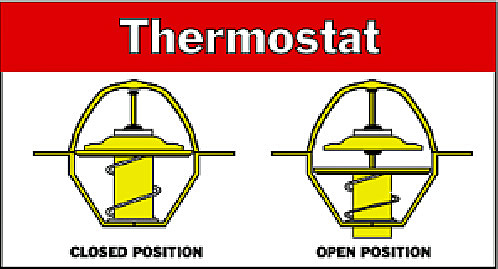 overheating. It does not. Those who suggest it does, should be avoided. Their logic is faulty. To forestall objections, I will place links below of others hoping to stop engine damage and the confusion the misguided cause.
overheating. It does not. Those who suggest it does, should be avoided. Their logic is faulty. To forestall objections, I will place links below of others hoping to stop engine damage and the confusion the misguided cause.
Each engine has an ideal running temperature, a small range that
is excellent for engine block health, the fueling system and
environment. As well, running with a cold engine is a no-no..especially
at start up. To create that range and heat to it quickly, engines use
automobile thermostats. This is a small heat responsive valve that
takes the cooling system on or off gradually by slowly blocking
or opening the coolant flow at a predetermined temperature set at
the low end of the desired ideal running range. At startup, by blocking
coolant flow until the lower end of that range is reach, is forces the
engine to heat to the proper running temp quickly. Once the lower end
of the range is reached, it will open, putting the cooling system
online. If the engine reaches the top end of the range, the rad fan
comes on, presumably preventing the engine from overheating. The
racing community will often try to force a cooler mixture (to create a
bit more power in an environment and game that has no emissions rules).
For some reason (aka nonsense) people are wrongly taught that
the automobile thermostat is somehow a device that can be used to COOL
a car????? This is anything but true. It is a device that protects the
car against overly cool temperatures that damage it and hurt your fuel
mileage. This is especially important for later (post 1995) EFI cars. If you have overheating problems, look instead to the
equipment you use for cooling, namely the radiator or rad fan
efficiency or the rad fan switch. Do not suppose that a problem with high temperatures is dealt with by fiddling with the low end of acceptable temperatures. Makes no sense.
The only result of a lower temperature thermostat is to force your car
to take longer to reach its proper running range. At worst, it will
allow the engine to run at unhealthy termperatures for longer. It will
not cure your over-heating issues
| WATCHPOINT Carb'ed engines often run at a lower range than their EFI counterparts. This is why they are less fuel efficient. For example, the Plus 8 runs a thermostats with an opening temperature of 82C with carbs but 88C with EFI. |
SUPPORTING LINKS
The Plus 8s Gauge's Cooling Sender
by Chris Beck and Lorne Goldman
Morgans have 2-3 sensors for coolant temperature, depending on whether the model you have is carb'ed or EFI
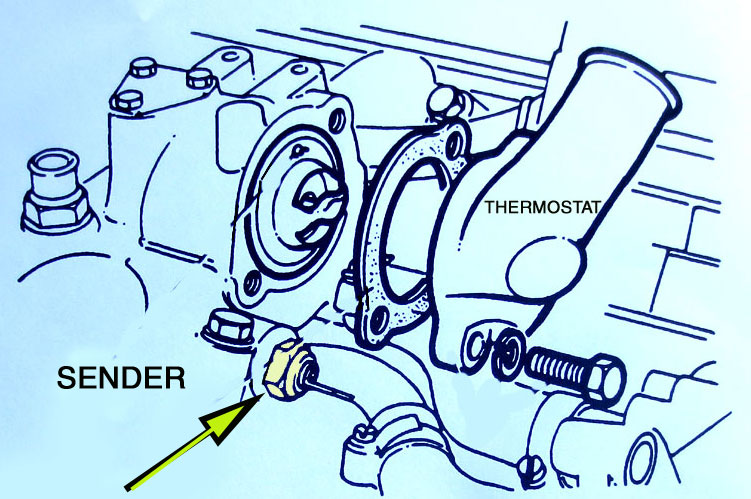
1. An "Otter" (UK terminology) or rad fan switch that turns on the rad fan when the coolant goes over a certain range.
2. A "thermomister" in EFI systems that reports the coolant temperaure to the ECU (engine management computer)
3. A coolant temperature sender from the engine to the engine temperature gauge on your dash.
This note deals with #3. It is a single wire affair that is behind the
alternator and next to the Thermostat, where the coolant is always at
it's hottest, just before it enters the radiator. Losing
it when you are working in the area is quite common. It can make the
gauge have weird readings or none at all, but it does NOT effect the
running of the engine as the other coolant sensors will.
The wire (should be green with a blue
tracer...but decades is a LONG time to keep all the original
wiring!). It runs from the sensor through a hole in the inner wing
(valence) adjacent, often under the alternator. However, when
unattached, the wire often falls down or can even be pulled into
and through the valence hole. Trust me, it is there somewhere. You
can also perhaps trace it from the other end..It merely is a
simple wire that runs from sender to gauge.
The other
thing to note is that it sends a reading of the temperature of
the coolant at the TOP of the engine, where it is at its hottest. Your
rad fan sender is at the BOTTOM of the rad, where the coolant is at its
coolest. With that in mind, you can check that they are both operating
correctly after you figure out the difference (in different driving
circumstances).
Plus 8s & Cooling (et al) Component Confusion (1995-2004)
by Lorne Goldman
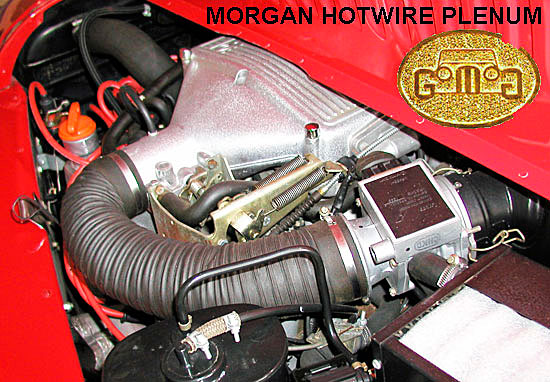
The Confusion.
In the last 2 days, my inbox has been filling with cooling
questions from Plus 8 owners. There must be a forum or "guru" somewhere
feeding that part of the community with erroneous information. This is
understandable as Morgan Plus 8s departed from the then current Land Rover norms from 1989 on. It is further complicated for owners and their mechanics as, for a period during that era, Morgan
used a different fueling system and ignition system for cars they sent
overseas (the majority of Plus 8s from 1999 to 2004)
from the cars they sold to the UK and Europe. So not only are the Morgan setups different from Land Rover's, they are 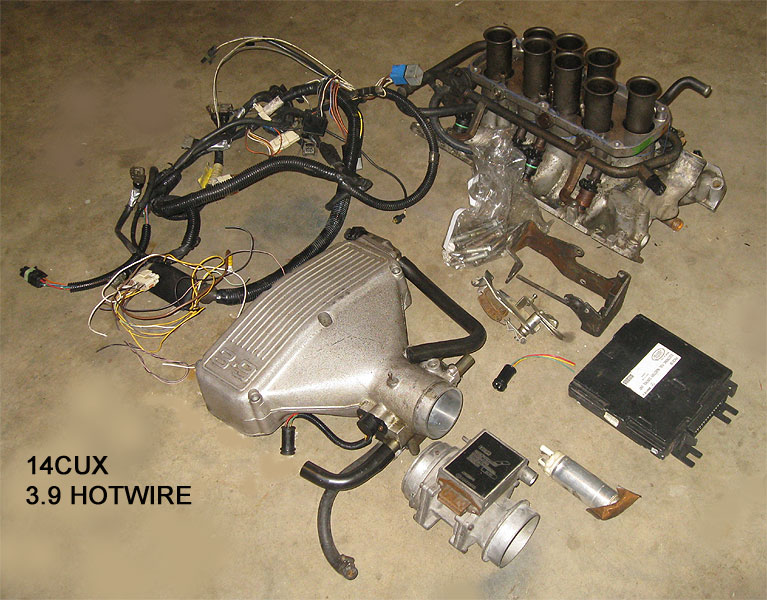 different
from each other!! The confusion gets worse as Land Rover was
selling diesel models as well! If you look for a part, mechanic
or owner, and you give the engine maker, model and year, you will often
be giving the wrong part. And then who checks the supplied part?!!
different
from each other!! The confusion gets worse as Land Rover was
selling diesel models as well! If you look for a part, mechanic
or owner, and you give the engine maker, model and year, you will often
be giving the wrong part. And then who checks the supplied part?!!
Let's start with basics. Land Rover
had a number of V8 engine variations and three (3) fueling &
ignition systems in the period from 1994-2002. 13CU
Hotwires(1987-1988) 14CU Hotwires in 1989 and finally 14CUX HOTWIRES, 1990-1995. The Land Rover GEMS era spanned 1995-1999. Finally, Land Rover moved to BOSCH MOTRONICS 5.2.1 in early 1999-2002. This last system was NEVER used on Morgan Plus 8s. The Morgan Compnay ceased producing Plus 8s when they could no longer source the correct version of GEMS and they ran out of the safety bag system.
Morgan,
on the other hand, would delay moving to new fueling/emissions systems
(for reasons of costly testing) as long as they could. AND new
emissions and safety regimes have long grace periods, varying from
country to country. As well, grace periods and emissions/safety
standards vary from jurisdiction to jurisdication. During this
period, UK/European standards were lower than Overseas. Morgan used the FLAPPER (Bosch L-Jetronics) 4CU system until late 1990. Then they switched to the 14CUX HOTWIRES from then until very late 1999 in the UK/Europe and until 1996 Overseas. Overseas. Morgan used a bespke version of GEMS
from 1998-2000 (though these dates are misleading as Morgan labelled
later cars earlier to allow the importation). From 2000, all Plus 8s,
European/UK or Overseas, used the standard GEMS system that the Land
Rover had used (see above) from 1995-1999!
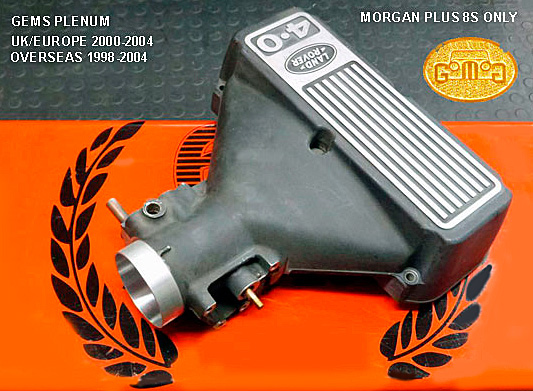
You can see how easy it is for suppliers, owners and even experts, to
get component confused. Only that era's Morgan cogniescenti have an
easy time with it. Later and earlier pros and amateurs simply make
mistakes. Of course, in most cases, the wrong component simply does not
fit or work and the only things lost is time and frustration. However,
in some cases, the wrong components fit!! This creates long term
problems. Let's examine the issue of cooling components, which are
interchangeable among all versions of the Plus 8 from the early Buick
215 to the last 4.0/4.6 LR blocks, most specifically the rad fan switch and the thermostats.
As noted above, the happy running temperature
range of a engine/fueling/ignition combination is fairly small. This is
the range where the engine runs it's most efficiently and where
internal damage can best be avoided. Lower temperatures may produce a
bit more power at lower rpms, but the engine innards will reflect the
lower temps in unhelpful gunk and goo.Trust me I have seen too many of those! IMHO, it
is advisable for racers only who need the power, couldn't care less
about emissions and are always running at high gunk-eliminating rpm. Higher
tempertures provide a better "burn" and mileage but increase the
compression chamber stress on the block. For these reasons, you want to make sure your temperature range is strictly reflected in your choice of thermostat and rad fan switch. Outside
of the risks to those of us with annual emissions testing, the longer
term consequences of getting these two items wrong are unpleasant.
This confusion on components makes this a regular problem. The Land
Rover change from a 3.5 to 3.9 block weakening the the block integrity
and as combustion chamber temperatures were incrementally increased
over time, they ran into a plague of slipped liners and cracked blocks..ultimately causing them to abandon the engine entirely. RELAX !! The low weight of a Morgan Plus 8 does not create enough of load on the engine to make these failures a Morgan experience. Why
I mention it is because Land Rover attempted to address the problem
(unsuccessfully) by trying to lower the block temperatures with the
advent of their new fueling with GEMS engines (1995) and continued this
with the Bosch Motronics. They dropped the EFI V8 cooling
range with GEMS from the HOTWIRES by 4C (that is a lot). With the
Motronics they went further, with the thermostat opening at 6C cooler
but upping the coolant presure from 15/16psi to 20psi!! But nothing helped.
In Conclusion
So who should you ask what components to buy and how your Morgan of the era (1995-2004) should be behaving?
If you blithely state to a supplier that your Plus 8 is the same
as a Land Rover V8 Discovery or Range Rover, give them the year, you
will get the wrong component. If you ask the question of savvy UK Morgan supplier for a Overseas Plus 8,
you will most likely get the wrong part. In reverse, if you ask an
Overseas Morgan expert for a part for a UK Plus 8, you will also be
ill-advised. Asking Land Rover people people is almost always a sure
error and even those who have "Morgan parts" listed by year on their
computer are invariably wrong. Auto supply computers are most often mistakenly programmed for Morgan with Land Rover suggestions.
I have even come across Plus 8ers with V8 diesel parts, running with a
80C thermostat!!!!! The temperature gauge is not a guide as few
owners regularly check its connection on the engine, which has a
tendency of rusting a bit, thereby prejudicing its reading on the dash
guage.
The consequences of using the incorrect components in the
engine area the cooling area can be sad. The car cannot achieve its
correct running temperature, the milegage will suffer and the engine
innards will become filthy. You can consult the block number to see what the version you have, but your best bet is to ask someone with knowledge what Land Rover and year your Morgan Plus 8 matches.
Be very wary of who you choose. For example, if it is someone who tuned
engines for racing that might be an error. I have heard that a former
Morgan racer preparer recently advised a forum to use a 80C
thermostat!!!
I will make it easy, for a starter, in this area. ALL EFI
Plus 8 Morgan should be running with 88C opening thermostats unless
they have a GEMS Plus 8 when a 85C (+ or - 5C) thermostats could
be used. If your car cannot achieve these temperatures, you can
assume that something is amiss as the cooling system is, de facto, shut
off until these miniums are reached. Here are snippets from the relevant Land Rover Manuals.

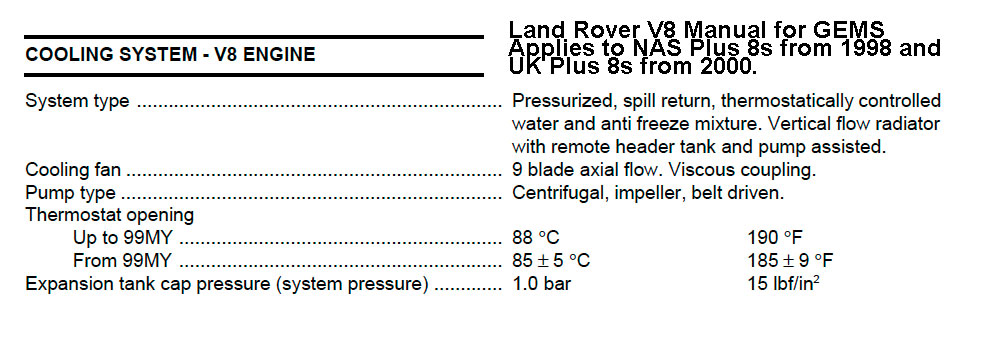
 Even
better than 2. install an air scoop that will
funnel large amounts of cool low air into the front of the radiator. A
scoop can double the air flow into the rad. There is a Morganesque version
designed by Maurice Owen and Bill Fink that replaces the original scuttle
(the piece at the bottom of the grill cowl attached to the wings) with
a new scuttle shaped "S" funnel that forces the air up from under the car
and into the rad. It is remarkable how well these scoops can work. They
are available from Isis Imports in San francisco or from the Morgan Factory.
Even
better than 2. install an air scoop that will
funnel large amounts of cool low air into the front of the radiator. A
scoop can double the air flow into the rad. There is a Morganesque version
designed by Maurice Owen and Bill Fink that replaces the original scuttle
(the piece at the bottom of the grill cowl attached to the wings) with
a new scuttle shaped "S" funnel that forces the air up from under the car
and into the rad. It is remarkable how well these scoops can work. They
are available from Isis Imports in San francisco or from the Morgan Factory.
 For
some time, there has been an option increasingly offered of coating your
manifolds or heddars with a ceramic based compound that very much lowers
the heat of this part of your exhaust system..a prime radiator of heat.
Essentially the compound..in a choice of colors or effects, is sprayed
on your clean sandblasted manifolds and then baked. It is inexpensive and
aethetically very good looking, replacing the rust that all Morgan manifolds
arrive with even when new. It does not discolor as does stainless steel
(which doesn't lower heat).
For
some time, there has been an option increasingly offered of coating your
manifolds or heddars with a ceramic based compound that very much lowers
the heat of this part of your exhaust system..a prime radiator of heat.
Essentially the compound..in a choice of colors or effects, is sprayed
on your clean sandblasted manifolds and then baked. It is inexpensive and
aethetically very good looking, replacing the rust that all Morgan manifolds
arrive with even when new. It does not discolor as does stainless steel
(which doesn't lower heat).
 Curiously,
I have only found one coating service in the UK or Europe..though they
are common now in North America, New Zealand, Australia, and Japan.
Curiously,
I have only found one coating service in the UK or Europe..though they
are common now in North America, New Zealand, Australia, and Japan.
 overheating.
overheating. 

 different
from each other!! The confusion gets worse as Land Rover was
selling diesel models as well! If you look for a part, mechanic
or owner, and you give the engine maker, model and year, you will often
be giving the wrong part. And then who checks the supplied part?!!
different
from each other!! The confusion gets worse as Land Rover was
selling diesel models as well! If you look for a part, mechanic
or owner, and you give the engine maker, model and year, you will often
be giving the wrong part. And then who checks the supplied part?!!

